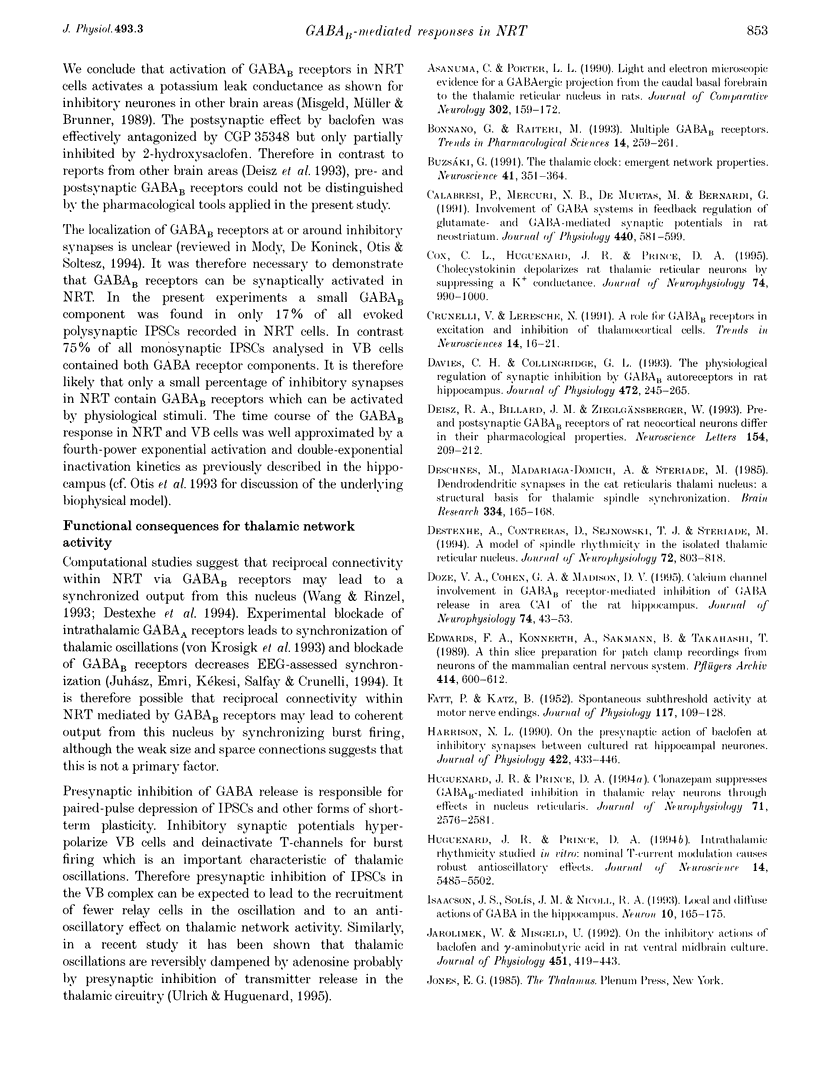Abstract
1. Whole-cell voltage-clamp recordings were obtained from GABAergic neurones of rat nucleus reticularis thalami (NRT) in vitro to assess pre- and postsynaptic GABAB receptor-mediated responses. Presynaptic inhibition of GABA release was studied at terminals on local axon collaterals within NRT as well as on projection fibres in the somatosensory relay nuclei. 2. The GABAB receptor agonist (R)-baclofen (10 microM) reduced monosynaptically evoked GABAA-mediated inhibitory postsynaptic currents (IPSCs) in NRT and somatosensory relay cells to 11 and 12% of control, respectively. 3. Action potential-independent miniature IPSCs (mIPSCs) were observed in both cell types. Mean mIPSC amplitude was 20 pA in both NRT and relay cells at a holding potential of 0 mV. The mean mIPSC frequencies were 0.83 and 2.2 Hz in NRT and relay cells, respectively. Baclofen decreased mIPSP frequency by about half in each cell type without affecting amplitude. 4. Paired-burst inhibition of evoked IPSCs was studied in relay and NRT cells by applying pairs of 100 Hz stimulus bursts separated by 600 ms. The mean ratio of second to first peak IPSC amplitudes was 0.77. 5. In NRT cells baclofen induced a linear postsynaptic conductance increase of 0.82 nS with an associated reversal potential of -121 mV. A small (0.14 nS) GABAB component of the evoked IPSC was detected in only a minority of NRT cells (3 of 18). 6. All pre- and postsynaptic effects of baclofen, as well as PBI, were largely reversed by the specific GABAB receptor antagonist CGP 35348 (0.5 mM). 7. We conclude that activation of GABAB receptors in NRT leads to presynaptic autoinhibition of IPSCs in both NRT and relay cells, and to direct activation of a small linear K+ conductance. In addition our experiments suggest that reciprocal connectivity within NRT can be partially mediated by a small GABAB inhibitory event.
Full text
PDF









Selected References
These references are in PubMed. This may not be the complete list of references from this article.
- FATT P., KATZ B. Spontaneous subthreshold activity at motor nerve endings. J Physiol. 1952 May;117(1):109–128. [PMC free article] [PubMed] [Google Scholar]
- Juhász G., Emri Z., Kékesi K. A., Salfay O., Crunelli V. Blockade of thalamic GABAB receptors decreases EEG synchronization. Neurosci Lett. 1994 May 19;172(1-2):155–158. doi: 10.1016/0304-3940(94)90685-8. [DOI] [PubMed] [Google Scholar]
- Misgeld U., Müller W., Brunner H. Effects of (-)baclofen on inhibitory neurons in the guinea pig hippocampal slice. Pflugers Arch. 1989 Jun;414(2):139–144. doi: 10.1007/BF00580955. [DOI] [PubMed] [Google Scholar]
- Mody I., De Koninck Y., Otis T. S., Soltesz I. Bridging the cleft at GABA synapses in the brain. Trends Neurosci. 1994 Dec;17(12):517–525. doi: 10.1016/0166-2236(94)90155-4. [DOI] [PubMed] [Google Scholar]
- Nicoll R. A., Malenka R. C., Kauer J. A. Functional comparison of neurotransmitter receptor subtypes in mammalian central nervous system. Physiol Rev. 1990 Apr;70(2):513–565. doi: 10.1152/physrev.1990.70.2.513. [DOI] [PubMed] [Google Scholar]
- Otis T. S., De Koninck Y., Mody I. Characterization of synaptically elicited GABAB responses using patch-clamp recordings in rat hippocampal slices. J Physiol. 1993 Apr;463:391–407. doi: 10.1113/jphysiol.1993.sp019600. [DOI] [PMC free article] [PubMed] [Google Scholar]
- Ropert N., Miles R., Korn H. Characteristics of miniature inhibitory postsynaptic currents in CA1 pyramidal neurones of rat hippocampus. J Physiol. 1990 Sep;428:707–722. doi: 10.1113/jphysiol.1990.sp018236. [DOI] [PMC free article] [PubMed] [Google Scholar]
- Soltesz I., Crunelli V. GABAA and pre- and post-synaptic GABAB receptor-mediated responses in the lateral geniculate nucleus. Prog Brain Res. 1992;90:151–169. doi: 10.1016/s0079-6123(08)63613-4. [DOI] [PubMed] [Google Scholar]
- Spreafico R., de Curtis M., Frassoni C., Avanzini G. Electrophysiological characteristics of morphologically identified reticular thalamic neurons from rat slices. Neuroscience. 1988 Nov;27(2):629–638. doi: 10.1016/0306-4522(88)90294-1. [DOI] [PubMed] [Google Scholar]
- Steriade M., Domich L., Oakson G., Deschênes M. The deafferented reticular thalamic nucleus generates spindle rhythmicity. J Neurophysiol. 1987 Jan;57(1):260–273. doi: 10.1152/jn.1987.57.1.260. [DOI] [PubMed] [Google Scholar]
- Thompson S. M., Gähwiler B. H. Comparison of the actions of baclofen at pre- and postsynaptic receptors in the rat hippocampus in vitro. J Physiol. 1992;451:329–345. doi: 10.1113/jphysiol.1992.sp019167. [DOI] [PMC free article] [PubMed] [Google Scholar]
- Turgeon S. M., Albin R. L. Postnatal ontogeny of GABAB binding in rat brain. Neuroscience. 1994 Sep;62(2):601–613. doi: 10.1016/0306-4522(94)90392-1. [DOI] [PubMed] [Google Scholar]
- Ulrich D., Huguenard J. R. Purinergic inhibition of GABA and glutamate release in the thalamus: implications for thalamic network activity. Neuron. 1995 Oct;15(4):909–918. doi: 10.1016/0896-6273(95)90181-7. [DOI] [PubMed] [Google Scholar]
- Van der Kloot W. The regulation of quantal size. Prog Neurobiol. 1991;36(2):93–130. doi: 10.1016/0301-0082(91)90019-w. [DOI] [PubMed] [Google Scholar]


